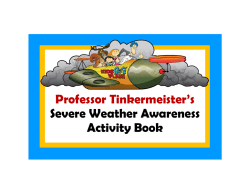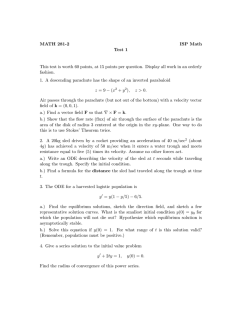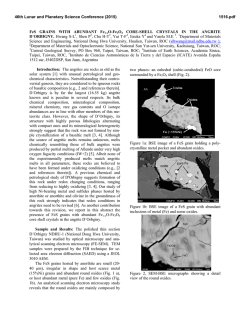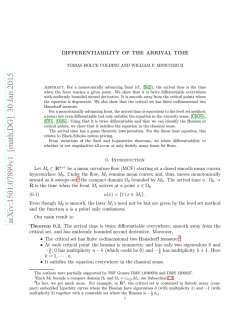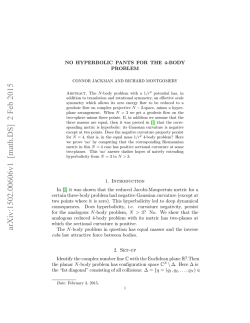
W» I??
N. TESLA. LIGHTNING PROTECTOR. APPLICATION FILED MAY 6.1916. 1,266,175. . a. J W» I?? @Mm Patented Ma'y14,1918. UNITED sTATEs PATENT OEE-ICE. NIKOLA TESLA, 0F NEW YORK, N. Y'. _ LIGHTNIN(1f-PROTECTOR. Speciiication of Letters liatent. ______‘___]?a,tentçd May 14, 1918. 1,266,175. Application ñled May 6, 19.16.' Serial No. 95,830. , I small radius,lor pointed, and- it is pursuant ‘ To all Íwhom, ¿t may concern.' Be it known that I, NIKOLAA TESLA, a citi to a misapplication of these, and other, ~zen of the United States, residin at New .truths that the commercial lightning rod of York, in the county and State of ew York, today is _made very slender and pointed._ My have invented certain new and useful Im invention, on the contrary, While taking 60~ Aprovements in Lightning-Protectors, of cognizance of these truths, correctly applies act description. them in the provision of a lightning pro tector that distinctively affords an elevated improved design ,strictly in conformity With of curvature on two dimensions.A The prin which the following is a full, clear, and eX _ terminal having its outer conducting boun The Iobject of the present invention is vprovide lightning protectors of-a novel and daries arranged on surfaces of large radii l0 65 the true character of the phenomena,'more ciples which underlie my invention and cor efficient inaction, and far more dependable rect application of which dictate the form in safe-guarding life and property, than and manner of installation of my protector, I Will now explain in contrast Withthe con 70 those heretofore employed. 15 _ To an understanding of the nature of my- invention and its basic distinction from the lightning rods of common use, it is nec 2O 25 30 35 ventional pointed lightning rod. ' _ , In permitting leakage into the air, the needle-shaped lightning-rod is popularly essary briefly to explain the principles upon believed to perform two functions: one to which my protector is designed as contrast~l drain the ground of its negative electricity, ed with >those underlying the now-prevail the other to neutralize the positive of the clouds. To some degree, it does both. But ing type of lightning rod. Since the introduction of the lightning a systematic study of electrical disturbances rod by Benjamin Franklin in the latter in the earth has made it palpably _evident part of the eighteenth century, its adoption that the action of Franklin’s conductor, as as a means of _protection against destructive commonly interpreted, is chiefly illusionary. atmospheric discharges has been practically Actual measurement proves the quantity of universal. Its eíiicacy, to a certain degree, _ electricity escaping even from many points., has been unquestionably establishe'd throu h ' to be entirely insignificant when compared with that induced within a considerable ter statistical records but there is genera prevalent, nevertheless, a singular theoreti restrial area, and of no moment whatever in cal fallacy as to its operation, and. _its con thel process of dissipation. But it is true struction is radically defective in one 4fea-v that the negatively_'charged air in the vi 75 80 85 ture, namely its typical pointed terminal. cinity of the ro , rendered conductive. 90 through the infiuence of the same, facilitates In my lightning protector I avoid points, the >passage of the bolt. Therefore it in and vuse an entirely different type of ter minal. . ' ~ ^ According to the prevailing o inion, the creases the probability of a lighting. dis chargel in its vicinity. The fundamental lvirtue of the Franklin type of lig tning rod facts underlying this type of lightning-rod 40 ' is largely based on the property of points or i sharp edges to give off electrlcity into the are: First, it. attracts li htning, so that it 95 will be struck oftener t an would be the if it~were not present; second, it air. As shown by Coulomb, _the quantityíof building renders harmless most, but not all, of the electricity per unit area, deslgnated by 1m “electrical density” increases as the radius of curvature of the surface is reduced. Sub discharges lwhich it receives; third, by ren dering the _air conductive, - and for other 100 sequently it was proved, by mathematical reasons. it is sometimes the cause of damage analysis, that the accumulated charge cre toneighboring objects; and fourth, on t e ated an outward normal-force equal yto 21: whole, its power of preventin injury re 50 ci limes thc square-of the density, and experi' d'ominates, more or less, over t e hazar s it nieut has demonstrated that when the latter exceeds approximately 20 C. G. S. units, a invites. ' ' 105 My protector, by contrast, is founded on streamer or corona 'is formed.A From these principles diametrically opposite. Its ter observations and deductions it is obvious that such may happen at a comparatively low density and ¿preserves the insulating minal has a large surface. It secures a very low pressure if the conductor is of extremely qualities of the ambient medium, thereby 110 1,266,175 y minimizing leakage, and in thus acting as a being struck is decreased by the presence of quasi-repellant t0 increase enormously the my protector, whereas it would be increased by the presence of the Franklin rod, for rea safety factor.l '. For the bestand most economical installa sons .that I will nowexplain. . An understanding of but part of the ' invention, those factors and phenomena that truths relative vto electrical discharges, and tion, of protective devices according to 'my dictate size, number of protectors and`phys 70 their niisapplication due to the want of - ical qualities of the apparatusV must be lfuller appreciation has doubtless been re 10 grasped by the installing engineer, and pre sponsible for the Frankliniightning rod . liminarily, for full ' understanding of the taking its conventional pointed form, but 75 principles of my invention, these shoilld be theoretical considerations, and the imp_ortant briefly explained. - discoveries that have been made in the.> ' course of investigations with a _wireless mands that the protective capability of any transmitter of great activity by which arcs - Economical installation, of course, de 15 given equipment be not needlessly greater ~ of a volume and tension comparable _to those 80 than is required'` to meet the ymaximum ex pectancies under the conditions surroundin occurring in nature were obtained (“Prob-` lems of Increasing Human Energy” Century the-particular building to be protected,- andl Magasz'ne June 1900 and Patents 645,576, " these depend,- partially, as I shall show, '649,621, 787 ,.412 and 1,119,732) at once estab lish the fallacy of the hitherto prevailing 20 upon the character of the landscape proxi mate'to the building site. l' notion on which the Franklin type‘of _rofl is based, show the distinctive novelty of my lightning protector, and guide the c’onstruc . In _the drawings,y Figures 1 to 4: inclusive, are diagrams requisite to illustration of the facts and conditionsy relevant to the deterf 25 mination of s eciíic installations of my iii vention, and igs. 5 to. 8v illustrate construc v tion and application of the protectors.‘ Spe cifically: 30 v 85 tor in the use of my invention. ' In Fig. 2, 5 is a small sphere in contact with a large one, 6, partly shown. Itcan 90 be proved by the theory of lelectric images that when the two bodies are charged the _ Fig. 1 is_a’_landscape suited for purpose mean density on the small one will be only of explanation; Figs. 2, 3 andiare theoreti 95 cal diagrams; Figs. 5 and 6 illustrate forms . 35 of improved protectors; and Figs. 7 and 8 show buildings equipped with the same. _times greater than that on the other, (See In Fig. 1, 1 representsLord Kelvin’s “re “Electricity ami Magnetísnt” by Clerk Y duced” areay of the region, which is virtually _ Maxwell); In Fig. 3, the two spheres 7 and 100 part of the extended un‘ruíiled ocean-surface. 8 are placed some distance apart and con (See “Papers on Electrostaties and Maguet ism” by Sir William Thomson). Under 0r dinary weather conditions, when the sky is clear, the total amount of ,electricity dis nected through a thin wire 9. This system that on the large~one. tributed over the land is nearly the same as the same potential it follows directly .that having been excited asbefore, the density onv the'small sphere is likely to be many times Since both are at ,105 that which would be containedl within its the densities on them will be inversely as horizontal. projection. But in times of their radii___of curvature. If the density of storm, owing to the inductive action of the 7 b_e designated as d and the radius 1', then the charge g=41w2d, the potential prima 45 clouds, an immensev char e may be accu ' mulated in the locality, _t e density being and the outward force, normal to the sur greatest at the' most elevated“ ort'ions of face, )hi-2MP. As before stated, when (l the' ground. _ Assumingthis, un er the'con 50 surpasses 20 C. G. S. units, the force f be ditions existing at any moment, -let another comes su'íiiciently intense to break down the spherical surface 2, ,coimentric with the dielectric an‘da streamer'or corona appears. 115 earth, be >drawn--whic‘h maybe calleduelec-` In this case ¿0:80am Hence, with a sphere tricalV niveau”-such .that thev quantities A of one -centimeter radius disruption would’ ,stored over and under it are equal. In othery .take place at a potentialnp=801cl=251~328 words,_ their algebraic sum, taken relatively E. S. units, or 75,398.4 volts. In reality,`the~ 55 to the imaginary surface,'in~the positive and dischargeV occurs at a lower pressure .as a 120 vnegative sense, is m2. Obíects above the consequence of uneven distribution on’> the mveau are exposed to ever so much more - small sphere, the density being greatest on risk than'those belowJ?Thus, a building atvy the side turned away from the large one. l( 7’ ' ' _3,'on a site_of excessive density, is apt tabel In this respect the behavior of 'a pointed ' conductor is just the reverse. Theoretically. 122x 60 hit sooner or later, while one in a depression ' 4, where the charge per unit area is very it mèäht erroneously be inferred from- the small,> is almost entirely safe. It "follows prec ing, that sharp projections would per lthat `the one' building 3 >requires more ex» mitl _electricity lto escape- at the lowest po~ tensive equipment than does the other. In tentials, butthis does not follow. The rea instances,> however, the probabilitygof. son willbeclea-r from an inspectionfof Fig. 130 8 meant 4, in which such a needle-shapedconductor stantiate >the desirability of establishing l10, is illustrated, a minute portion of its protection by avoiding such drainage. 'The tapering end being 'marked 11;* Were this ’ density at t e pointe 10 end f should be in portion removed from the large part 10 and :versely as -the radiusof curvature of the electrically connected with the same through surface, fbut such -acondition is unrealizable. 70 an infinitely thin wire, the charge would be Suppose Fig. 4 to represent a conductor of _ given off readily. vBut the resence of 10 radiusV 100.times lthat of the needle; then, has the eifect of reducingt e capacity of although its' surface per unit length is 11, so that a much lhigher pressure 4is re greater 1in the. same radio, the capacity isv quired to raise Vthe density to-.the critical onlydoubl'e. Thus, while twice the quan 75. value._ The larger the body, th_e morepro tity of electricity is stored, the density on/nounced is this influence, which is also de-Í ‘the rod is but one-fiftieth of that on the nee pendent on configuration, andis maximum d'1e,_from >whichit follows that the' latter for a sphere. 15 When the same is of con siderable size it'takes a much greater elec is far more eßicient.“ But the emissive power of any v_such conductor is v circumscribed. 80 tromotive force than under ordinary circum~ Imagine that the “pointed” (in reality blunt stances to produce streamers from the point. or rounded) end- be continuously reduced in To explain this apparent anomaly attention size so yas to approximate the ideal more and 20 is called to Fig. 3. 'If the radii of the twospheres, 7 and 8, be designated r and _Bre spectively, their charges g and 'Q `and the distance between their centers D, the po more. Duringthe process of reduction, the -den/sity willbe increasing as the radius of 85 curvature gets smaller, but in a proportion distinctly ess than linear;` on «the other hand, the area ofthe extreme end,l that is, ' tential at_7, due to Q is `But-77 owing to v the section through which the(- charge passes _25 the metallic' connection 9, is at the pot'el'itial-y 'out into the air, will be diminishing as the .90 square _of the radius. This relation alone imposes a definite limit to the performance Q q of a pointed conductor, and i‘t should be notice that the electrode-resistance would 2 30 When D is comparable to R, the medium be augmented at 'the same time. Further 95 ' surrounding the small sphere will ordinarily ~m0re, the eiîicacy of the rod is much vim AVbe at a potential not much different from „ paired through potential due to the charge of the ground, as has been indicated with have to be applied before streamers' issue, reference» to Fig. 3. Practical estimates of even from sharpprotruding edges. yIt is the electrical uantities concerned in natural“ 1:00 important to bear this in mind, for the disturbances s ow, moreover, how absolutely that of the latter and millions of volts may earth is but a vast conducting globe. It i follows that a pointed lightning-rod must impossible are the functions attributed to' the ointed lightning conductor. A single be run far above ground in order to operate clou' ma contain 2><1012 C. G. S. units, or at all, and from the foregoing it will be ap more, in ucing in the earth an equivalent 105 parent that the pointing of the end, for ¢sup , posed emissive effect, is in part neutralized__ by the increasing size below the eXtreme end, and the larger the rod, for reduction of elec 45 trode resistance, the more pronounced is this 55 amount, which a number of lightning rods' could vnot neutralize in many years. Par ticularly to instance conditions that may Ihave to be met, reference is madeto the Electrical World of March 5, 1904, >wherein 1.10 counter-iníiuence. ’ For these reasons it is it ap ears that upon one .occasion approxi important to .bear in mind that su?licient thickness of the'rodfor very low electrode resi’stance is rather incompatible with the high emissive capability sought in the nee dle-like Franklin-rod, but, as hereinafter set forth, it is wholly desirable in the use mate y 12,000 ,strokes occurred within two hours within a radius oflvless than 50 kilo- » meters from the pla/ce of observation. _ But although the pointed lightning-rod 115 is' quite ineíl’eëtive’in the one respect noted, it has the property of attracting lightning of‘my invention, wherein the terminal con-' to a high degree, firstly on account of its struction is intended for ' suppression of> shape and'secondly because it ionizes _and renders 'conductive the' surroundin air. charge-emission rather than to foster it. 120 The notion that Franklin’s device would This has been unquestionably’establis ed in ' be effective in dissipating terrestrial charges long continued testswith the wireless trans 'may be traced to early experiments with mitter above-mentioned, and in this feature static frictional machines, when a__needle _lies the chief disadvantageA of the Franklin f 6.0 was found capable of q-uickly draining an type of apparatus. ,_ All ,of> the foregoing serves ' insulated electriíied body. But the inappli- _ cability of this fact to th'e conditions of ` 125 to show that since it is utterly impracticable to effect an lightning protection will be evident from equalization of charges emissively through examination of the simple theoretical prin pointed lightning-rods underithe conditions ciples involved, which at the same time sub-. presented 'by the vast :forces of naturev great 130». 11,266,115 4 improvement lies in the attainment of---a protectors if equipped with suitable devices minimized probability 'of lightning stroke or designed in conformity with this inven to the area' to be rotectedcoupled with tion.' Still another modification is illustrated ' adequate conductivlty to render harmless in Fig. 8 in which,~-instead of one, four those strokes that may, notwithstanding, vgrounded barsare provided with as many occur. . 70 s un, shells or attachments 18, with the ob Furthermore, la correct’itpplication ofthe vious obj ect of reducin the risk. truths that have thus been explained with l From the foregoing 1t will be clear that in I reference to the familiar pointed type of all cases the terminal prevents leakage of 75. lightning-rod not only substantiates the electricity and attendant ionization of the theoretical propriety of the form 'in which I air. It is immaterial to this end whether it develo my improvedlightning protector, is insulated'or not. S ‘ould it be struck the current will pass readily to the ground either but wiil lead the` installing engineer properly directly or, as in Fig. 5, through a small air to take cognizance of those conditions due to location of the building, with respect to gap between 12 and 14. But such an acci 80 surrounding earth `formati/ons and other dent is rendered extremely improbable ow- v ` buildings, probabilities of maximum poten ing to the fa‘ct that there are everywhere tial-differences and charge-densities to be ex "` polnts and projections on which the terres charge attains a high density and where pected under the prevailing atmospheric trial the air is ionized.y Thus the action of the im-V 20 conditions of the site, and deslrable electrode resistance and capacities of the- protectors proved protector is equivalent to a repellant force. This being so, it is not necessary to installed. ` at a great height, bu the ground The improved protector, as above stated, support‘it ' behaves in ama-nner just opposite to the connection should be made wit the usual 90 care and the conductor leading> to it must be 25 Franklin type and is incomparably safer for of as small a self-induction and resistance as this reason. The result is secured by the use4 of a‘terminal or conducting surface of large I claim as my invention: ' radius of curvature and suflicient area to make the density very small and thereby A 1. A lightning protector consisting of an 95. elevated terminal, having its outer conduct30 prevent the leakage of the charge and the ionization of the air. The device may be in boundaries arranged on surfaces of large greatly varied in size and shape but it is es raäii of curvature in both dimensions, and a sential that all its outer conducting elements grounded conductor of small self-induction, ' should be disposed along an ideal enveloping as set forth. 2. A lightnin . protector composed of a 100 surface o’f large radius and that they should metallic shell o large radius of curvature, have a considerable total area. . practicable. l \ ' ' In Fig. 5, Fig. 6, Fig. 7 and Fig. 8, differ-À and a grounded fconductor of small self-in ` ent vkinds of such terminals and arrange duction, as described.f 3. Apparatus for protection against at ments offsarne are illustrated. In Fig. 5, 12 mospherlc discharges comprising an earth 40 is a cast or spun metal shell of ellipsoidal connection of small resistance, a >conductor outlines, having on its underV side a sleeve with a bushing 13 of orcelain or other in of small self-induction and a terminal car ried by the same and having a large radius sulating material, a apted to be -~sl1ppe_d of curvature _in two dimensions as. and for _ tightly on a rod 14, which may be an orda 45 nary lightning conductor. Fig. 6 shows a the4. purpose -In apparatus set forth. for prgtection > against at terminal 15 made up. »of rounded or fiat metal bars radiatin from a central hub, mospherie discharges an insulated metallic ' 50 ` -110 _which is supported lrectly on a similar rod shell of large radius of curvature supported and in electrical contact with the same. The b a grounded conductor and separated from special object of this type is to reduce the t e same through a small air-gap as, and for y ' A wind resistance, but it is essential that the the purpose described. 5.’A` lightning protector comprising, in. bars have a sufficient area to insure small density, and also> that they are( close enough combination, an elevated terminal of large to make the aggregate capacity nearly equal area and radius of curvature in two dimen 55 to that of a continuous shell of the same out sions, and a grounded conductor of small side dimensions. In Fig. 7 a cupola-shaped and earthed roof is carried by a chimney, self~induction, as set forth. ' 120 j 6. In ap aratus for protection against serving in this way the twofold practical lightning discharges, the combination of an purpose of Íhood and protector. Anykind elevated metallic _roof of large area and GO of metal may be used in its construction but radius of curvature in two dimensions, and it is indispensable that its outer surface a grounded conductory of small .self-induc should be free of sharp edges and projec tion and resistance, as described. tions i’rom which streamers might emanate. 7 . As an article of manufacture a me In like manner lnuiiiers, funnels and vents tallic shell of large radius of curvature pro may be transformed into effective lightning vided with apsleeve adapted for attachment 130 1,266,175 to a lightning rod as, and for the purpose set forth. 5, mospheríc discharges a cupola-shaped me tallic terminal of smooth outer surface, in y 8. A lightning protector comprising an combination with a grounded conductor of 10 ellipsoidal metallic shell and a grounded small self-induction and resistance, as de 5 conductor of small self-induction, as set scribed. In testimony whereof I aiiix my signature. NIKOLA TESLA. 9. In apparatus for protection against at# forth. . y ‘
© Copyright 2026

